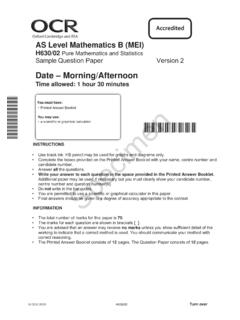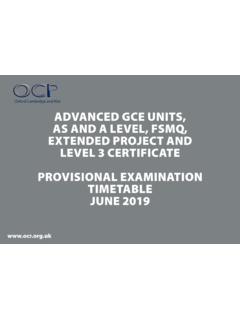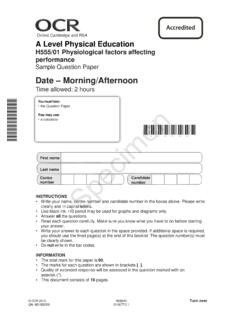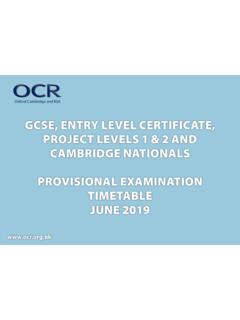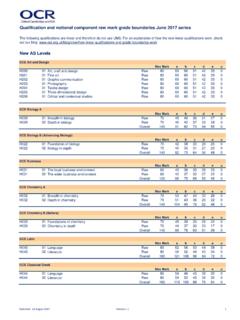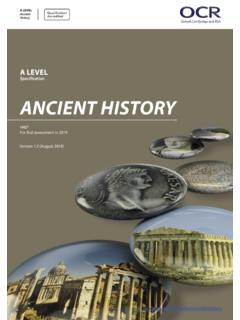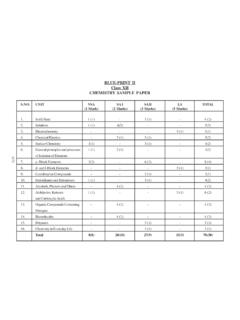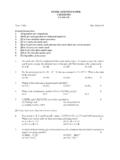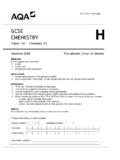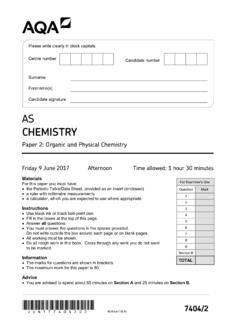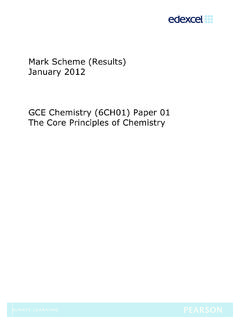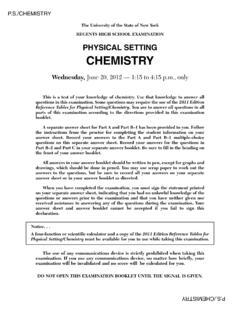Transcription of OCR AS Level Chemistry A (H032/02): Depth in …
1 OCR 2016 h032 /02 [601/5256/4] DC (..) Turn over AS Level Chemistry A h032 /02 Depth in Chemistry Sample Question paper Date Morning/Afternoon Version time allowed: 1 hour 30 minutes You must have: the Data Sheet for Chemistry A You may use: a scientific or graphical calculator * 0 0 0 0 0 0 * First name Last name Centre number Candidate number INSTRUCTIONS Use black ink. HB pencil may be used for graphs and diagrams only. Complete the boxes above with your name, centre number and candidate number. Answer all the questions. Where appropriate, your answers should be supported with working.
2 Marks may be given for a correct method even if the answer is incorrect. Write your answer to each question in the space provided. Additional paper may be used if required but you must clearly show your candidate number, centre number and question number(s). Do not write in the bar codes. INFORMATION The total mark for this paper is 70. The marks for each question are shown in brackets [ ]. Quality of extended responses will be assessed in questions marked with an asterisk (*). This document consists of 20 pages. SPECIMEN2 OCR 2016 h032 /02 Answer all the questions. 1 Bromine is a reactive element.
3 It combines with other non-metals to form covalent compounds. Phosphorus tribromide, PBr3, and iodine monobromide, IBr, are examples of covalent compounds used in organic synthesis. (a) PBr3 can be prepared by heating bromine with phosphorus, P4. (i) Write an equation for this reaction.. [1] (ii) How many molecules are present in g of PBr3? number of molecules = .. [3] (iii) The dot-and-cross diagram of a molecule of PBr3 is given below. Name the shape of this molecule and explain why the molecule has this shape. name: .. explanation: .. [3] SPECIMEN3 OCR 2016 h032 /02 Turn over (b) Bromine reacts with iodine to form iodine monobromide, IBr.
4 The table below lists some average bond enthalpies which are required in different parts of this question. Bond Average bond enthalpy / kJ mol 1 Br Br +193 I I +151 I Br +175 (i) Average bond enthalpy is the enthalpy change for the breaking of 1 mole of bonds in gaseous molecules. Why do Br2 and I2 not exist in the gaseous state under standard conditions? .. [1] (ii) Calculate the enthalpy change of formation, fH, for IBr. fH = .. kJ mol 1 [2] (c) Iodine monobromide, I Br, is a polar molecule. Heterolytic fission of the I Br bond forms an electrophile. State the meaning of the term electrophile and suggest the formula of the electrophile formed from IBr.
5 [2] (d) Bromine disproportionates when it reacts with potassium hydroxide solution. Suggest an equation for this reaction.. [1] SPECIMEN4 OCR 2016 h032 /02 BLANK PAGE SPECIMEN5 OCR 2016 h032 /02 Turn over 2 A large proportion of the world s output of organic chemicals is used to make addition polymers. These polymers have a variety of uses. (a) Poly(propene) is used to make packaging, textiles and rope. A repeat unit for poly(propene) is shown below. (i) Explain why poly(propene) is a saturated hydrocarbon.. [1] (ii) State the bond angle around each carbon atom in poly(propene).
6 [1] (iii) After polymers have been used for packaging, the waste polymers need to be processed to save resources, for example, by recycling. Describe two other ways in which waste poly(propene) can be processed in a sustainable way.. [2] SPECIMEN6 OCR 2016 h032 /02 (b) Poly(ethenol) is used to make soluble laundry bags. A section of the structure of poly(ethenol) is shown below. (i) Draw a structure to represent one repeat unit of poly(ethenol). [1] (ii) Poly(ethenol) is not manufactured from ethenol. Ethenol is unstable and it forms a more stable structural isomer.
7 Analysis of the structural isomer gave the following data. Infrared spectrum SPECIMEN7 OCR 2016 h032 /02 Turn over Mass spectrum Use all the data to show that the isomer is not ethenol. Identify the structural isomer of ethenol. In your answer you should make clear how your explanation is linked to the evidence.. [4] SPECIMEN8 OCR 2016 h032 /02 3 Nitrogen can be reacted with hydrogen in the presence of a catalyst to make ammonia in the Haber process. N2(g) + 3H2(g) 2NH3(g) H = 92 kJ mol 1 (a) Describe and explain the effect of increasing the pressure on the rate of this reaction.
8 [2] (b) A mixture of N2 and H2 was left to react until it reached equilibrium. The equilibrium mixture had the following composition: N2 mol dm 3 H2 mol dm 3 NH3 mol dm 3 (i) Calculate a value for Kc for this equilibrium. Kc = .. dm6 mol 2 [3] (ii) Explain how the following changes would affect the amount of NH3 present in the equilibrium mixture. Use of a catalyst: .. A higher temperature: .. [3] SPECIMEN9 OCR 2016 h032 /02 Turn over (c) tonne of ammonia from the Haber process is reacted with carbon dioxide to prepare the fertiliser urea, NH2 CONH2.
9 2NH3(g) + CO2(g) NH2 CONH2(s) + H2O(l) tonnes of urea are formed. Calculate the percentage yield of urea. yield = .. % [3] SPECIMEN10 OCR 2016 h032 /02 4 Students work together in groups to identify four different solutions. Each solution contains one of the following compounds: ammonium sulfate, (NH4)2SO4 sodium sulfate, Na2SO4 sodium chloride, NaCl potassium bromide, KBr. Your group has been provided with universal indicator paper and the following test reagents: barium chloride solution silver nitrate solution dilute ammonia solution sodium hydroxide solution.
10 (a)* A student in your group suggests the following plan: Add about 1 cm Depth of each solution into separate test-tubes. Add a few drops of barium chloride solution to each test-tube. A white precipitate will show which solutions contain sulfate ions. Two of the solutions will form a white precipitate. Describe how you would expand this plan so that all four solutions could be identified using a positive test result. You should provide observations and conclusions that would enable your group to identify all four solutions. [6] .. SPECIMEN11 OCR 2016 h032 /02 Turn over .. Additional answer space if required.
